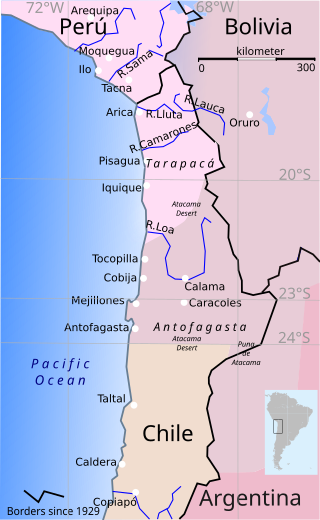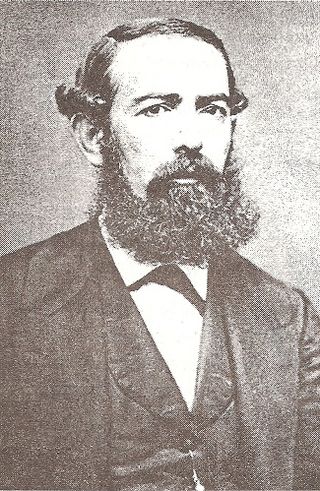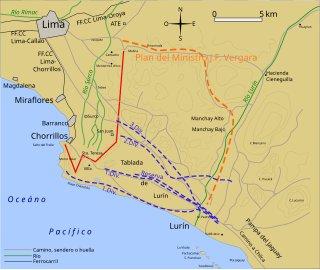Peruvian culture is the gradual blending of Amerindian cultures with European and Asian ethnic groups. The ethnic diversity and rugged geography of Peru allowed diverse traditions and customs to co-exist. Peruvian culture has been deeply influenced by Native culture, Spanish culture, and Asian culture. Other minor influences on their culture are Chinese, Japanese, and other European peoples.

The War of the Pacific, also known as the Nitrate War and by multiple other names, was a war between Chile and a Bolivian–Peruvian alliance from 1879 to 1884. Fought over Chilean claims on coastal Bolivian territory in the Atacama Desert, the war ended with victory for Chile, which gained a significant amount of resource-rich territory from Peru and Bolivia.

The Historic Centre of Lima is the historic city centre of the city of Lima, the capital of Peru. Located in the city's districts of Lima and Rímac, both in the Rímac Valley, it consists of two areas: the first is the Monumental Zone established by the Peruvian government in 1972, and the second one—contained within the first one—is the World Heritage Site established by UNESCO in 1988, whose buildings are marked with the organisation's black-and-white shield.

Justiniano Borgoño Castañeda was a Peruvian brigadier general and politician who served as the 29th President of Peru, an office he held for four months. The son of a brigadier general in the Peruvian Army, Borgoño left behind agricultural administration to join the Army following the outbreak of the Peruvian Civil War of 1856–1858. He returned to military service nearly twenty years later to serve in the War of the Pacific, during which he survived a leg wound and being taken as a prisoner of war for three months.

The Chile–Peru football rivalry is a long-standing association football rivalry between the national football teams of Peru and Chile and their respective aficionados. Both teams compete in FIFA's South American Football Confederation (CONMEBOL). Matches between the two nations are keenly contested and their games have a reputation for fierceness in and off the field of play, fueled by political disputes.

The Battle of San Juan, also known as the Battle of San Juan and Chorrillos, was the first of two battles in the Lima Campaign during the War of the Pacific, and was fought on 13 January 1881. This battle is really a group of smaller, yet fierce confrontations at the defensive strongholds of Villa, Chorrillos, Santiago de Surco, San Juan de Miraflores, Santa Teresa and Morro Solar. The Chilean army led by Gen. Manuel Baquedano inflicted a harsh defeat on the Peruvian army commanded by the Supreme Chief Nicolás de Piérola. The Chilean triumph eliminated the first defensive line guarding Lima, and almost obliterated the Peruvian army defending it.

The occupation of Lima by the Chilean Army in 1881-1883 was an event in the land campaign phase of the War of the Pacific (1879-1883).

The Chilean occupation of Peru began on November 2, 1879, with the beginning of the Tarapacá campaign during the War of the Pacific. The Chilean Army successfully defeated the Peruvian Army and occupied the southern Peruvian territories of Tarapacá, Arica and Tacna. By January 1881, the Chilean army had reached Lima, and on January 17 of the same year, the occupation of Lima began.

The Maritime history of Chile started when Chile gained independence, but traces it origin in the colonial era and has ultimately origin in the seafaring tradition of the Iberian Peninsula, Europe and the Mediterranean as well as from indigenous peoples of Chile.

The Lima campaign is the third land campaign of the War of the Pacific, carried out by Chile between December 1880 and January 1881. The campaign ended with the Chilean occupation of the Peruvian capital and the establishment of the Chilean authority in it and other surrounding territories, which would extend until 1883, with the end of the war.

Juan Gastó Valderrama was a Peruvian colonel who participated prominently in the Sierra Campaign of the War of the Pacific and was in the Peruvian army for forty years. During his military service, he was the main commander of the Peruvian victories at the Battle of La Concepción and the Battle of Tarmatambo. He participated at the Battle of Huamachuco as head of the 2nd division of the Army of the Center where he was killed in action at the age of 59.

Arnaldo Panizo Avasolo was a Peruvian general of the 1857–1860 Ecuadorian–Peruvian War and the War of the Pacific as well as a key commander of the Lima campaign.

Justo Pastor Dávila Herrera (1829-1901) was a Peruvian colonel who was a primary commander throughout the Lima campaign as well as the Sierra campaign during the War of the Pacific as well as the Prefect of Tarapacá in 1879.

Carlos Ferreyros y Senra was a Peruvian Navy officer and politician. He was the commander of the gunboat Pilcomayo during the War of the Pacific, commanding it before its capture. He was also a Senator of the Department of Huánuco from July 28, 1907, to February 6, 1910, where he died in office.

The Battle of La Rinconada de Ate took place during the Lima campaign of the War of the Pacific. The battle occurred a few days before the Battle of San Juan and Chorrillos due to a surveying conflict.

The October 9 Revolution was a successful revolt against the Spanish Empire in Guayaquil on October 9, 1820. It was led by the General Antonio José de Sucre and directed by Simón Bolívar. The revolt established a revolutionary junta and created the Free Province of Guayaquil, an independent state. The independence of Guayaquil revived the war of independence of the Real Audiencia de Quito as part of the Spanish American wars of independence. Prominent events in the revolution include the uprising of the Spanish garrison in the city of Guayaquil and the control of the Pacific by the Liberating Expedition of Peru, under the command of José de San Martín.

Martiniano Urriola Guzmán was a Chilean colonel of the War of the Pacific. He participated across many campaigns of the war as well as being one of the primary commanders of the Chilean North Operations Army.

Teodomiro A. Gutiérrez Cuevas, also known by his pseudonym Rumi Maqui, was a Peruvian Army Major and Indigenous leader who led a rebellion in Puno in 1915. After his imprisonment, he escaped his prison in Arequipa in January 1917.

José Gregorio Castro Miranda, O.F.M., was a Roman Catholic prelate who was Bishop of Cuzco from 1910 to 1917. He mainly worked to integrate the local indigenous population to the church's teachings by translating prayers and church music to Quechua.
La Planicie is a neighbourhood in La Molina District, Lima, Peru. A gated community, it is inhabited by upper-class families and considered one of the most exclusive and expensive areas of the city.

















